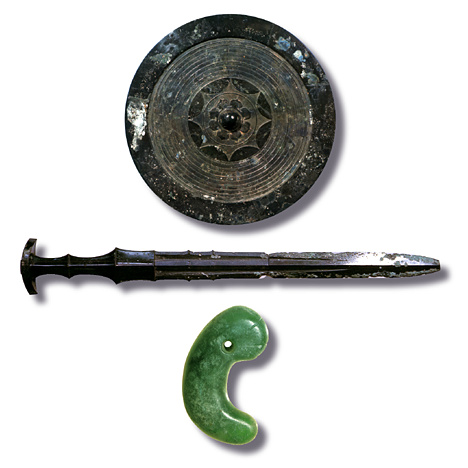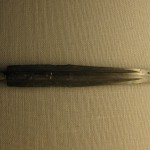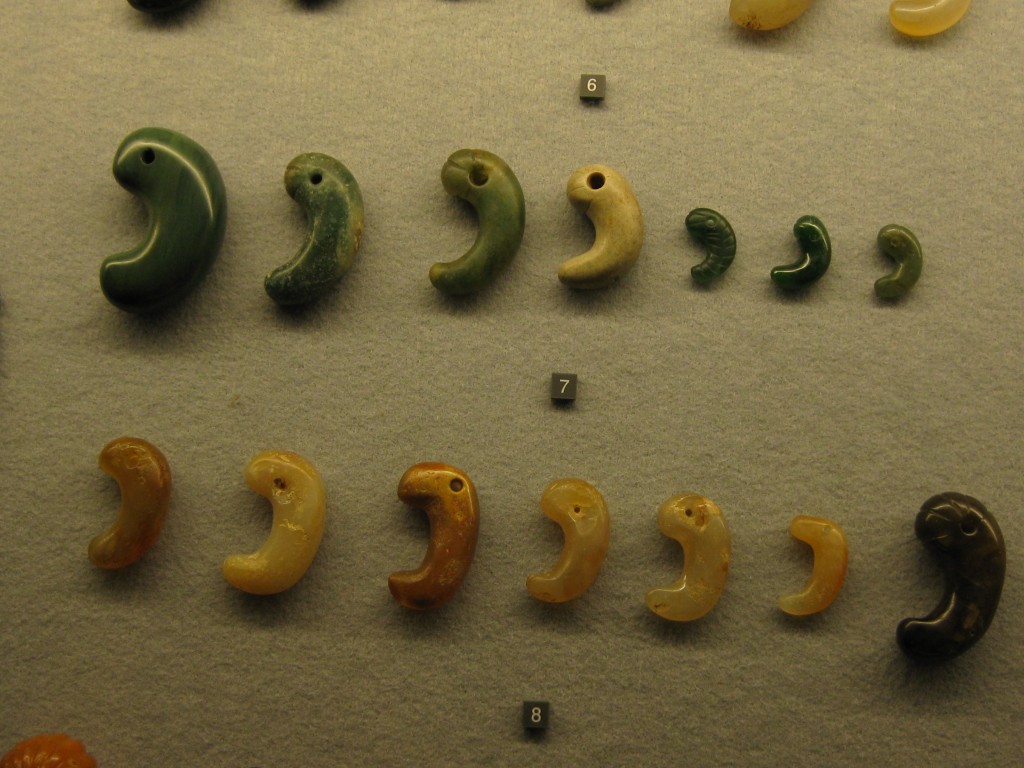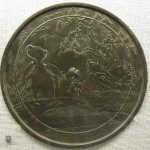The Imperial Family is identified with three sacred objects — the mirror, sword and curved jewel, or magatama. According to mythology, they were handed by Amaterasu, the sun goddess, to Ninigi when he descended from heaven and then passed along the imperial line. Historically, however, when exactly the three objects became symbols of the emperor’s family is not clear. They were already important religious symbols by the Middle Yayoi Period, and are abundant in the tombs of the Kofun Period. At some point they coalesced to indicate supreme authority. Now the mirror is supposedly in Ise Jingu, the sword at Atsuta Jinja and the magatama in the imperial palace in Tokyo.

The Three Sacred Treasures (photo courtesy of cyber shrine)
The roots of the mirror lie in China. Han Chinese mirrors were common in northwestern Kyushu by Middle Yayoi, though these were preceded by mirrors from Korea a bit earlier. It might have been simply a talisman to ward off evil. Mirrors were a major burial object in Kofun Period tombs, especially the earlier ones, but they were not necessarily associated with the other symbols. It is not known whether the ideas surrounding the mirror were imported from the continent together with the mirror, or whether the Yayoi people simply saw the mirror as a useful symbol for ideas they already had. At any rate in the Yamato age it became associated with the supreme goddess, Amaterasu, ancestor of the emperor.

Yayoi sword
The sword (or weapon) would seem to be a symbol of male virility with origins in the stone phallic symbols of Jomon times. By late Jomon the symbols looked more like stone swords than phalluses. Bronze swords and spears were imported from Korea from the end of the Early Yayoi period. Later ritual forms of the weapons were manufactured in Japan and are common in Yayoi sites — spears in northwestern Kyushu and swords in western Honshu and Shikoku. Swords are common in Kofun Period burials, especially the later ones. In Europe too they were symbols of spiritual authority (think of Excalibur), and Mircea Eliade has written of the religious significance of metal to early humans as a precious gift from a livinig earth.
The magatama’s origins are more controversial. These curved jewels of jadeite are common in Kofun Period burials, and are common also in Korean sites of the same age. This fact seems to have led archaeologists to conclude that the magatama originated in Korea. but magatama are found in Yayoi sites, too. No one seems to know what the shape represents exactly, but It is said to represent the soul. Tama in Japanese means jewel or ball, but originally also meant soul (as in tamashi, the Japanese word for soul or spirit). Some people say it’s a reduction of yin-yang to a single element, as if to signify the most basic element of life. I asked a leading archaeologist at my university about it, and he told me something rather surprising – he suspects it represents a hook, to ‘hook evil’ as it were. In other words a Yayoi era omamori! Look at the magatama in the bottom row below and you can see what he means…

Magatama collection at Kokugakuin University Museum


Christopher Spzilman writes…
Great site. When I read the bit about the imperial jewels, I was reminded of the following.
In the 1920s there was a big scandal when Professor Inoue Tetsujiro (1856-1944), a very conservative (reactionary) philosopher, wrote in one of his books that the imperial jewels were replicas. The originals, he pointed out, had been lost at sea when the Emperor Antoku drowned at Dan-no-ura in 1185. He was forced to resign from his various official positions and, when he appeared in public on one occasion, was attacked by “patriotic” thugs who gave him such a thrashing that he lost sight in one eye.
A frightening but all too credible story these days… Thank you for reminding us of the sensitivity of some issues and the dangers of speaking out.
They have Korean equivalent(s) as well:
http://japanesemonarchist.blogspot.com/2014/08/arguments-defending-yasukuni-shrine.html?m=1
My bad: WRONG URL!! -_-;; :-( :(
http://www.meta-religion.com/World_Religions/Ancient_religions/Asia/creation_myths_in_korea_and_japan.htm
The Mad Monarchist is not ‘wrong”, he is (almost) always right (and mad) ! :p
Btw, Korean Nationalists have the tendency to claim things originated from their country (also known as “Uriginal”), this came from Korean independance after WWII, when the new president and his advisors sought something to give pride to the Korean people. And since there was not much, especially after centuries of hellish Choson rule, they had to use fiction. This is how, for exemple, Koreans came to claim tea ceremony or Kanji were invented in Korea, or that the funder of the Qing dynasty was of Korean ancestry (implying he felt Korean). Other crazier exemples include samurai ripp off, or claims on American Indians.
I don’t say this Joo-Young Yoo is wrong, I don’t know enough about Korean mythology and culture for such a thing.
But one must not think “it came from Korea”, anyway Korea didn’t existed at that time, since what we think of as Korea was mostly born under Choson dynasty. The Korean peninsula in ancient times had rulers from many ethnicity, including people who directly came from Imperial China or Japanese islands. Koguryeo itself was multi-ethnic country, quite like Manchuria during the Dai Nippon Teikoku period.
After all, Kojiki is older by more than 4 centuries than Samguk Sagi. That’s more than enough for Korean myths to be lost or melding with myths FROM Japan.
Kusanagi no Tsurugi & Yamato Takeru no Mikoto, for exemple, have close link with Excalibur & King Arthur, through common middle-east ancestry. It is there that Iron tool forging was invented. So it can’t be “from” “Korea”, at best it could have passed by the Korean peninsula.
It is also hard to determine, just by reading this article, if the author know a lot about the Shinto’s Age of the Gods or not. For exemple, some theories regarding Susanoo and Tsukuyomi says they may have been originaly the same god… this is something the article’s author seemingly doesn’t know, but almost mention. It is important because it serves as basis for all Shintô and especially Kôdô (Imperial dogma and Ise teachings influencing primitive Shintoism). And it’s extremely coplicated and embroiled with esoterism, mysticism and Shinto metaphysics… Something Korean probably don’t have.
Shinto Genesis is far more sophisticated than Bible’s Genesis and probably closer to the truth (just one exemple : it doesn’t name a first man or woman, except Izanagi & Izanami, and doesn’t explain the creation of humankind but by Musubi enfolding… which is reminiscent of the theory of Evolution), after all, so it’s something Shintoists should be proud off.
I meant that it wasn’t the URL I meant to post, & I too, often find myself in agreement with him!! ;)